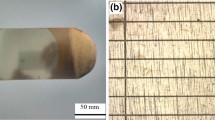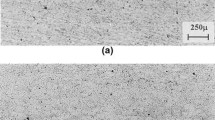Abstract
Although asymmetric rolling is employed extensively to produce ultrathin strips in micromanufacturing, microelectronics, and other high precision engineering fields, very limited attention has been given to the deformation zone, which is a direct result of the material thickness reduction behavior during asymmetric rolling. In this study, theoretical analysis of the minimum thickness of single-roll-driven asymmetric rolling is performed by combining FE (finite element) and theoretical analytical models to complete a comprehensive investigation. Based on the FE model calculation results, the deformation zone contour varies with reduction ratio, strip thickness, and yield strength; the Fleck model can be used to describe single-roll-driven asymmetric ultrathin strip rolling when the thickness is small enough. Different from symmetric rolling, a cross-shear zone is inevitably formed during asymmetric rolling, but the cross-shear force resulting from asymmetric rolls decreases and approaches 0 with smaller strip thickness, smaller reduction ratio, and higher yield strength, which means the rolling status of single-roll-driven asymmetric ultrathin strip rolling is very similar to symmetric rolling when the strip reaches its limiting minimum thickness. Therefore, a minimum thickness model is developed for single-roll-driven asymmetric ultrathin strip rolling with different roll diameters, mean tensions and strip yield strengths, and the elastic modulus and Poisson ratio of the two rolls are considered. Eventually, the minimum thickness for single-roll-driven asymmetric rolling of ultrathin strips is estimated using the new minimum thickness model, with further experimental verification by the single-roll-driven asymmetric rolling of various materials, including aluminum, 304 stainless steel, and both non-annealed and annealed copper. Compared with experimental results, the model is shown to be a possible alternative for more accurate minimum thickness prediction in single-roll-driven asymmetric rolling.


















Similar content being viewed by others
References
Hu, YJ, Sun J, Wang QL, Yin FC, Zhang DH (2018) Characteristic analysis and optimal control of the thickness and tension system on tandem cold rolling. Int J Adv Manuf Technol 1–16. https://doi.org/10.1007/s00170-018-3088-1
Hwang YM, Kan CC (2017) Roll shape design for foil rolling of a four-high mill. Int J Adv Manuf Technol 91(5–8):1587–1597. https://doi.org/10.1007/s00170-016-9843-2
Moazeni B, Salimi M (2015) Investigations on relations between shape defects and thickness profile variations in thin flat rolling. Int J Adv Manuf Technol 77(5–8):1315–1331. https://doi.org/10.1007/s00170-014-6544-6
Lee SH, Lee DN (2001) Analysis of deformation textures of asymmetrically rolled steel sheets. Int J Mech Sci 43(9):1997–2015. https://doi.org/10.1016/S0020-7403(01)00025-X
Qwamizadeh M, Kadkhodaei M, Salimi M (2012) Asymmetrical sheet rolling analysis and evaluation of developed curvature. Int J Adv Manuf Technol 61(1–4):227–235. https://doi.org/10.1007/s00170-011-3697
Richelsen AB (1997) Elastic—plastic analysis of the stress and strain distributions in asymmetric rolling. Int J Mech Sci 39(11):1199–1211. https://doi.org/10.1016/S0020-7403(97)00013-1
Mousavi SA, Ebrahimi SM, Madoliat R (2007) Three dimensional numerical analyses of asymmetric rolling. J Mater Process Technol 187:725–729. https://doi.org/10.1016/j.jmatprotec.2006.11.045
Müller M, Steinboeck A, Prinz K, Ettl A, Kugi A, Etzelsdorfer K, Fuchshumer S, Seyrkammer H (2019) Asymmetric hydrodynamic roll gap model and its experimental validation. Int J Adv Manuf Technol 100(9–12):3101–3111. https://doi.org/10.1007/s00170-018-2634-1
Gao H, Ramalingam SC, Barber GC, Chen G (2002) Analysis of asymmetrical cold rolling with varying coefficients of friction. J Mater Process Technol 124(1–2):178–182. https://doi.org/10.1016/s0924-0136(02)00131-0
Farhatnia F, Salimi M, Movahhedy MR (2006) Elasto-plastic finite element simulation of asymmetrical plate rolling using an ale approach. J Mater Process Technol 177(1–3):525–529. https://doi.org/10.1016/j.jmatprotec.2006.04.075
Jiang J, Ding Y, Zuo F, Shan A (2009) Mechanical properties and microstructures of ultrafine-grained pure aluminum by asymmetric rolling. Scr Mater 60(10):905–908. https://doi.org/10.1016/j.scriptamat.2009.02.016
Ji YH, Park JJ (2009) Development of severe plastic deformation by various asymmetric rolling processes. Mater Sci Eng A 499(1):14–17. https://doi.org/10.1016/j.msea.2007.11.099
Xu G, Cao X, Zhang T, Duan Y, Peng X, Deng Y, Yin Z (2016) Achieving high strain rate superplasticity of an Al-Mg-Sc-Zr alloy by a new asymmetrical rolling technology. Mater Sci Eng A 672:98–107. https://doi.org/10.1016/j.msea.2016.06.070
Holbrook RL, Zorowski CF (1966) Effects of nonsymmetry in strip rolling on single-roll drive mills. J Eng Ind 88(4):401–408. https://doi.org/10.1115/1.3672670
Luo DX, Chen QA, Liu LW (2004) Analysis of metal deformation in deformation zone for asymmetric rolling with different roller diameter. J Iron Steel Res 16(1):40–43. https://doi.org/10.1109/JLT.2003.821766
Stone MD (1953) Rolling of thin strip. Iron Steel Eng 30(2):61
Stone MD (1956) Rolling of thin strip partII. Iron Steel Eng 33(12):55
Ford H, Alexander JM (1960) Rolling hard materials in thin gauges basic consideration. J Inst Met 88(5):193
Fleck NA, Johnson KL (1987) Towards a new theory of cold rolling thin foil. Int J Mech Sci 29(7):507–524. https://doi.org/10.1016/0020-7403(87)90012-9
Fleck NA, Johnson KL, Mear ME, Zhang LC (1992) Cold rolling of foil. Proc Inst Mech Eng B J Eng Manuf 206(2):119–131. https://doi.org/10.1243/PIME_PROC_1992_206_064_02
**ao H, Ren ZK, Liu X (2017) New mechanism describing the limiting producible thickness in ultra-thin strip rolling. Int J Mech Sci 133:788–793. https://doi.org/10.1016/j.ijmecsci.2017.09.046
Tang D, Liu X, Song M, Yu H (2014) Experimental and theoretical study on minimum achievable foil thickness during asymmetric rolling. PLoS One 9(9):e106637. https://doi.org/10.1371/journal.pone.0106637
Tzou GY, Huang MN (2000) Study on the minimum thickness for the asymmetrical PV cold rolling of sheet. J Mater Process Technol 105(3):344–351. https://doi.org/10.1016/S0924-0136(00)00574-4
Tieu AK, Li EB, Liu YJ (2000) An experimental determination of friction in cold rolling. Tribology 38(6):467–472. https://doi.org/10.1016/S0167-8922(00)80151-0
Liu YJ, Tieu AK, Wang DD, Yuen WYD (2001) Friction measurement in cold rolling. J Mater Process Technol 111(1–3):142–145. https://doi.org/10.1016/S0924-0136(01)00541-6
Funding
This project is financially supported by the National Natural Science Foundation of China (Grant No. U1560206 and Grant No. 51374184).
Author information
Authors and Affiliations
Corresponding author
Additional information
Publisher’s note
Springer Nature remains neutral with regard to jurisdictional claims in published maps and institutional affiliations.
Rights and permissions
About this article
Cite this article
Feng, Y., Liu, W., Yang, T. et al. Theoretical and experimental analysis of the deformation zone and minimum thickness in single-roll-driven asymmetric ultrathin strip rolling. Int J Adv Manuf Technol 104, 2925–2937 (2019). https://doi.org/10.1007/s00170-019-04027-z
Received:
Accepted:
Published:
Issue Date:
DOI: https://doi.org/10.1007/s00170-019-04027-z




